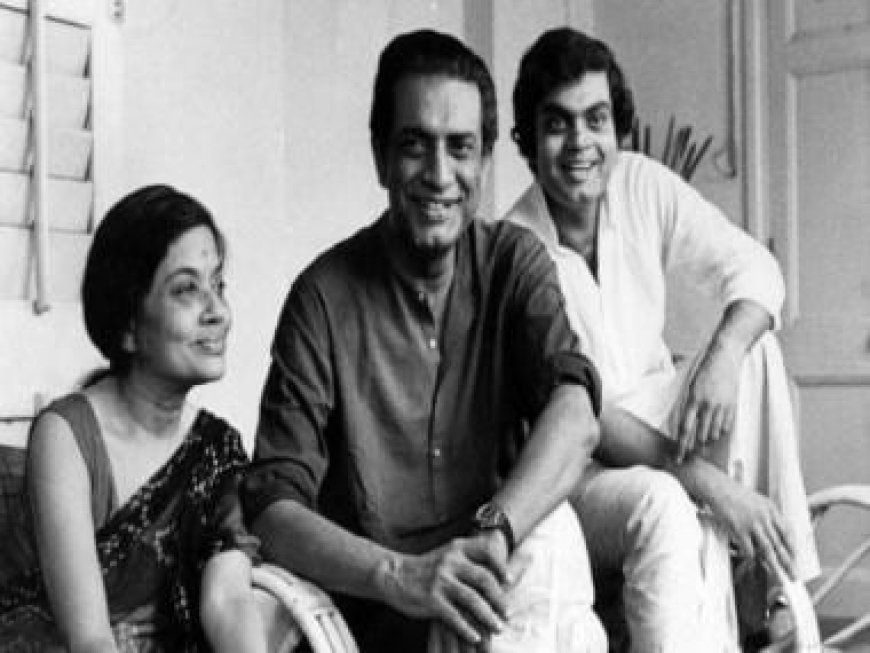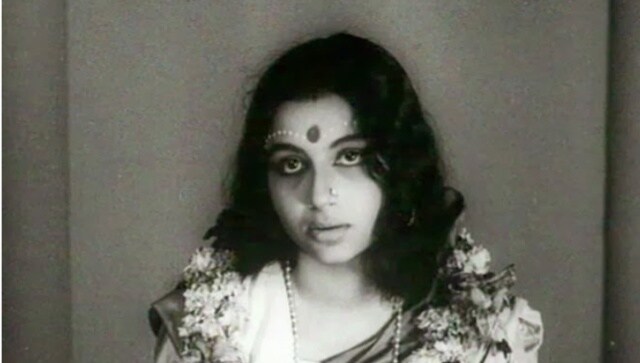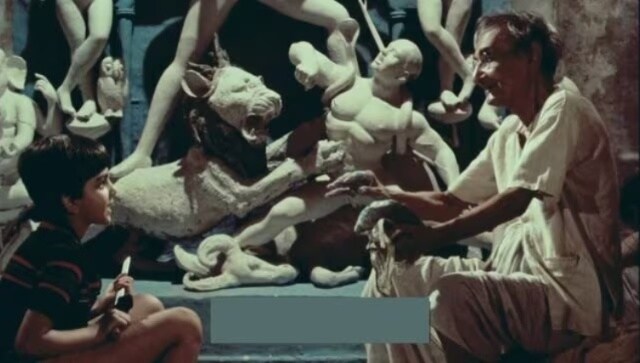Ray-esque | The connection of a few Satyajit Ray films and the icon of Goddess Durga
Ray-esque | The connection of a few Satyajit Ray films and the icon of Goddess Durga

The legendary Satyajit Ray dealt with Goddess Durga as an idol in a few films. Importantly, the image figures in three Ray titles: Devi (The Goddess), Nayak (The Hero) and Joy Baba Felunath (The Elephant God). Most prominent amongst these three are I and Joy Baba Felunath.

“Devi, of course, is one of those films of father’s where Durga, as a facet, figures very deeply. Rinkudi (Sharmila Tagore) was cast as Dayamoyee and as the movie progresses, she transforms to Devi or the incarnation of Durga. Father had to study various functions of the priest and rituals so that the film, in its final shape, turned out to be totally authentic. He had delved into Sanskrit slokas or chants. Of course, Chhabi Biswas, who played Soumitra’s Chatterjee’s father in the film, also helped him in this direction. Father also consulted people who were experts in these spheres. Devi is extremely detailed as far as these aspects are concerned. Otherwise, the entire film would fall apart. The logo that father illustrated in the film’s poster, with rays of light splaying out, poignantly reflects the content of the movie. Again, one must certainly give full kudos to renowned art director Bansi Chandragupta for constructing a fantastic set hovering around the goddess. In fact, he was also led to pick up quite a few nitty gritties about the goddess. The set was structured in the backlot of Technicians Studio. This helped father to utilise normal daylight. The night scenes were also shot there under natural light conditions. The Ghosal (the film name) household’s interiors in Joy Baba Felunath, which was huge, were built in Calcutta Movietone. These studios sported sprawling space in those days.
“The next film where the image of Durga features is Nayak where Shankarda’s character suffers a cardiac arrest while trying to lift the idol on the day of immersion in a flashback scene. And, of course, Durga plays an extremely crucial role in Joy Baba Felunath. The clue to the unravelling of the mystery, in fact, lies hidden in the Durga idol. More specifically in the statue of lion. It becomes a spoiler alert. These are the three films, I suppose, where the symbol of Durga was portrayed. I don’t recall any others,” says Sandip, allowing an insight into this subject.

He goes on to say that the play of superstitions which were thrown up in Devi created some amount of heartburn in a section of the audience. “Some letters also arrived at our residence which said that my father was interfering in the religious beliefs or sentiments of Bengalis. A few called, too, to express similar feelings to him. Of course, nothing escalated beyond the initial simmering of emotions,” recalls Sandip. Satyajit Ray felt that this story was very rich visually and cinematically. He was of the view it was extremely “filmable”, according to Sandip.
“Ultimately, the belief that Dayamoyee was the Goddess incarnate leads to a climax which is tremendously unfortunate. Devi’s life ends. The film depicts Sharmila gradually beginning to believe that she may actually be the goddess’ human extension. She’s in a dilemma. But, it’s only in the end when she goes mad that she shakes her head and then dies,” emotes Sandip. “And, camera pans to a skeletal bamboo structure of the goddess lying on the banks of a river.
“But, this is the Indian version. In the international depiction, the film ends with Devi disappearing in the morning mist. The finish is intensely powerful. The outdoor shooting of the film was based in Nimtita (also Jalsaghar or The Music Room’s location),” Sandip informs, bringing us abreast of Devi’s making. “The domestic and international version of the film were fashioned on the editing table. The end is deeply poignant,” he adds. “Even in Jalsaghar, a truck of the company run by the nouveau riche businessman passes by an elephant of Biswambar Ray, the true blue-blooded zamindar (Chhabi Biswas) raising a cloud of dust and shrouding the elephant. Symbolising the new tragically eclipsing the old. These films triggered thoughts in my father’s mind,” says Sandip reflectively.
According to him, the master had illustrated Chhabi Biswas’s dream sequence in Devi in great detail in the screenplay which shows Dayamoyee metaphorising into Devi. He had also drawn Dayamoyee’s demeanour after she loses her mind which helped the make-up artistes in his crew. “That was also a very striking illustration. Father’s script throws up experiments, too, with the logo for the posters. Otherwise, there are footnotes of Sanskrit slokas and the procedures followed by the priest,” says Sandip giving us a peep into Devi’s screenplay.
Devi’s narrative had haunted Satyajit Ray. The story is very “deeply rooted” in Bengali ethos. “Father had a great deal of conviction about the storyline. That is the reason why he selected the title for transcreating it into a film,” informs Sandip.
The sequence revolving around Goddess Durga in Nayak is for a few moments. But, after Devi, Joy Baba Felunath stands out prominently in depicting the goddess. In fact, the film virtually begins with showing the goddess being sculpted. “Durga keeps flitting in and out of the movie. The potter, Shashibabu (Santosh Singha) is murdered by Maganlal Megraj’s (the mafia don played by Utpal Dutt) henchman. The imagery of the idol is systematically present and shown in the film. There’s a fairly long passage in the film where Shashibabu explains to Ruku (the child) about the facets investing the goddess. So, Joy Baba Felunath is a significant film in this context,” Sandip stresses.
Of course, Feluda novels or novellas are strewn with mention of Durga Puja (Durga festival). But, not directly about the idol. Sandip goes on to expand the ambit of this subject and dwells on the fact that after the movie maestro donned the mantle of an author, he avidly contributed tales revolving around Feluda and Professor Shanku to the special editions of Sandesh and magazines published by the Ananda Bazar Patrika Group (ABP) during the Durga Puja festival every year. Other than writing and editing for Sandesh, te Ray family magazine, throughout the year. Interestingly, Joy Baba Felunath was published in Durga Puja special edition of ABP group’s Desh magazine. “In fact, in the storyline, Feluda, the detective, Topshe, his cousin and Lalmohan Babu, their friend, go for a vacation to Benares during the Pujas and then get entangled in a mystery plot,” points out Sandip. “Father would be under pressure to write for the special editions of Sandesh, Desh and Anandamela in the run-up to the Durga Pujas. He would also not only illustrate for his own writings, but for the maximum segment of contributors in Sandesh.”
“As a Brahmo, by belief and approach to life, he would not believe in idols or gods and goddesses. But, that doesn’t imply that he rejected the fact that Durga Puja was the prime festival of the Bengalis. So, he had an absolutely open mind. He always conveyed his thoughts about the idol through his characters. He aired that the traditional image of the idol always evoked reverence. I am not sure what father would have to say about today’s ‘theme pujas’. I don’t think he would have accepted them. Of course, a good many people are earning from catering to ‘theme pujas’.
“Father viewed the traditional Durga images with the ‘shola’ structure of the Durga idol as a truly artistic creation. He fathomed the aestheticism in the idol. Father believed in the conventional form of Durga, which is witnessed in Devi and Joy Baba Felunath. He also deeply appreciated the tradition of old Calcutta families continuing to celebrate Durga Pujas sticking by their conventions and forms,” underscores Sandip.
Interestingly, Sandip remembers that during the shooting of Joy Baba Felunath, the person who coloured the idol had vanished suddenly. Everyone looked around, but he was nowhere to be seen. “Father immediately took the paint brushes and applied colour on some portions of the goddess’ statuette. This is an exercise he was never called to practice ever earlier. So, he probably thought that there was little harm in trying it out for a change. We were all fascinated. He was always dabbling in innovative work. Even in Kala Bhavan, back in the Shantiniketan days, father had never sculpted. He was always into paintings. Of course, he was a great admirer of the famed sculptor Ram Kinkar Baij.
The maestro was an extremely broad-minded individual. Always keeping his mind’s windows open, to allow ideas to flow in from all quarters.
What's Your Reaction?



























































